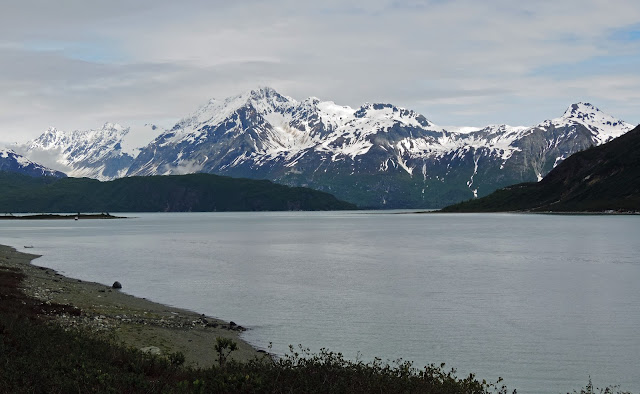Wildlife. Critters, as Jill prefers to describe them. Critters are one of Jill’s greatest joys while cruising and numerous encounters have been experienced over the many miles traveled on Last Dance, but no other cruising area even comes close to the variety and density of wildlife as does Alaska.
A couple eagles were sighted on bergie bits, the pieces of ice that calf off the glaciers. This one chose not to stay as Adventures approached his position.
Southeastern Alaska has two variety of bears, the brown bear and the black bear. Both are prolific. During our time in the park, the black bears were the ones interested in putting on a display. A couple were sighted along the shore. Near the park headquarters, where a number of hiking trails are maintained, the trails were closed for a while during our visit as three juvenile black bears roamed the area not sure of their purpose.
 |
| Robin Roberts Photo |
Previous cruises into Glacier Bay, discussions, and diligent research have helped Robin and Jim identify places where different species of wildlife prefer to come for the birthing season or where they feed. This knowledge allowed them to find many encounters with critters. Running the boat close to a vertical rock wall along the side of Gloomy Knob, mountain goats were spotted. Most had very new kids. A number were observed nursing. The goats have developed an uncanny ability to walk along these vertical walls, a place their predators will not chance.
Southern Marble Island is one of the smallest in the bay, but it teems with wildlife. From a distance, it looks like a white rock rising out of the deep bay. Closer viewing reveals many species of wildlife that make this island their home.
In this image, a large colony of Steller Sea Lions can be seen on the right. The glaciers polished many rock outcroppings on and around this island, providing smooth surfaces for the sea lions to sun.
Large males commanded harems of females, being always on the watch for any that might want to leave.
Southern Marble Island is also a rookery for a number of species of birds. The most colorful, in a cute and endearing way, is the Tufted Puffin. He differs from his eastern shore cousins from Nova Scotia in that there is a tuft of feathers running along the side of his head. A bit like he chooses a longer hairstyle combed back on the sides in a 1950s ducktail.
When taking off from the water, they run along the water to gain speed. Many were in the water each time we passed Southern Marble. Seems you cannot take your eyes away from the water as you marvel at these little creatures.
 |
| Robin Roberts Photo |
Maybe the highest ranking on the cuteness scale is the Sea Otter. They float on their backs. After retrieving a shellfish, they will lay a rock on their chest and pound the shell against it to break it open. The moms keep their young on their stomachs as they float. Or, maybe like this one, they just want to clap in welcome of the cruising boaters.
Harbor Seals give birth and raise their young on ice flows. They do not go ashore. Ice flows coming into the bay from John Hopkins Glacier had many Harbor Seals and their pups.
 Of course, the big sea creatures that all visitors hope to catch a glance of are the whales. Humpback Whales feed in Glacier Bay and all of the waterways among the islands of Southeastern Alaska. Whales are a challenge for the photographer. You hear them first, as they exhale a large plume of water mist into the air. Then, they dive down again giving no indication to the photographer where they might appear next. Some cameras have a bit of a delay between when the button is pressed and the shutter actually opens to capture the image making it even tougher to catch the whale above water. Robin has a camera holder that is much like a rifle stock, allowing a quick movement and a quick shot. This photographer did manage a couple whales in the viewfinder, but only minimally. In one, a Humpback cruises around the small cove where Adventures was anchored. In the second, a Humpback was feeding at the entrance to the marina in the small town of Hoonah. Captain Robin kept Adventures the appropriate distance away and willingly waited for the large creature to finish feeding and move out into the bay before approaching any closer to the marina.
Of course, the big sea creatures that all visitors hope to catch a glance of are the whales. Humpback Whales feed in Glacier Bay and all of the waterways among the islands of Southeastern Alaska. Whales are a challenge for the photographer. You hear them first, as they exhale a large plume of water mist into the air. Then, they dive down again giving no indication to the photographer where they might appear next. Some cameras have a bit of a delay between when the button is pressed and the shutter actually opens to capture the image making it even tougher to catch the whale above water. Robin has a camera holder that is much like a rifle stock, allowing a quick movement and a quick shot. This photographer did manage a couple whales in the viewfinder, but only minimally. In one, a Humpback cruises around the small cove where Adventures was anchored. In the second, a Humpback was feeding at the entrance to the marina in the small town of Hoonah. Captain Robin kept Adventures the appropriate distance away and willingly waited for the large creature to finish feeding and move out into the bay before approaching any closer to the marina.

















































